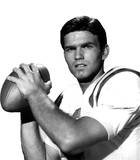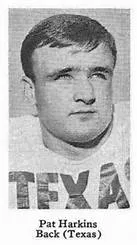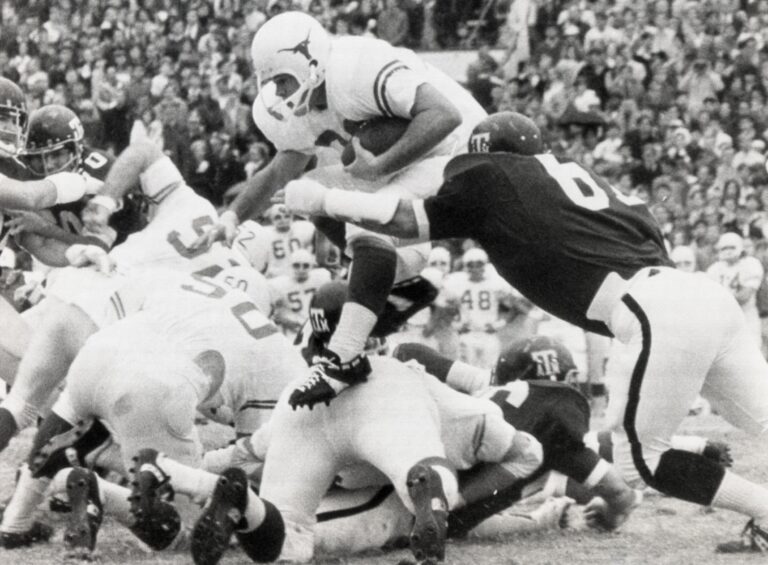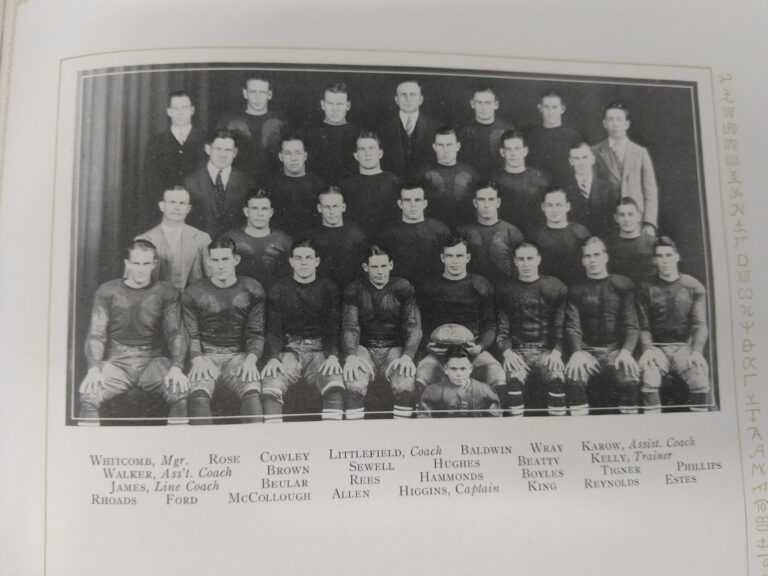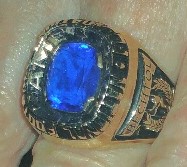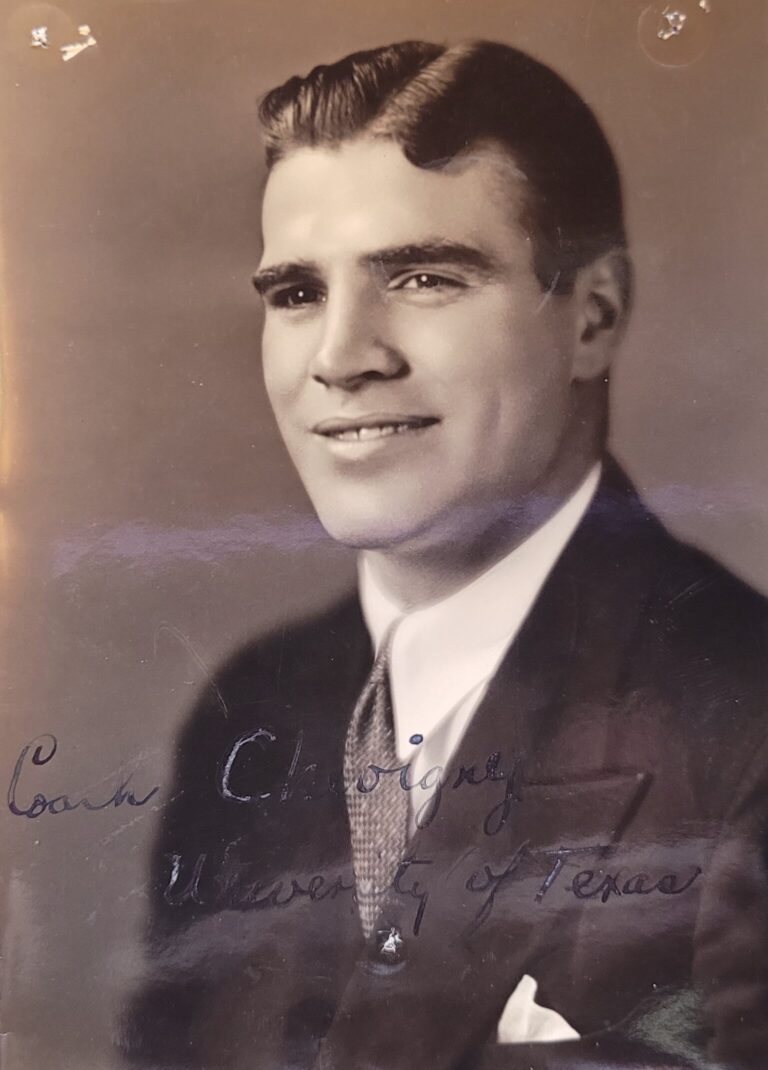Booger Brooks 1979
I remember this guy only for his name. But I heard he was all stud, then *POOF* he vanished. I damn sure remember Brad Beck. Damn, was all that really 30 years ago? A trip to the past: Thirty years ago blue-chip QB cashed out: Booger Brooks’ life after UT football
By John Maher
AMERICAN-STATESMAN STAFF
Sunday, March 16, 2008
Thirty years ago, Charles “Booger” Brooks took his first trip in an airplane, as an orange Learjet picked him up in Midland and whisked him and another prized football recruit to Austin.
A week after that flight, Brooks signed to play for the Longhorns of coach Fred Akers. Of the Dallas Times-Herald’s blue-chip list of the 15 prospects most wanted by Southwest Conference coaches, Brooks — a running quarterback from the West Texas town of Andrews — was one of seven to sign with Texas.
The Austin American-Statesman called it the best recruiting haul since the storied (Steve) Worster Bunch of 1967 and, noting that Booger also competed in rodeos, suggested that he might be a Longhorn version of Walt Garrison, the former Dallas Cowboys running back who did both sports.
Before he took a snap in a UT game, though, Brooks was gone. In the spring of his freshman year, he piled his belongings into his metallic green Grand Prix and put Austin and big-time college football in his rearview mirror, as he set off for West Texas.
Akers tried to talk him out of leaving, without success.
“You couldn’t help but like Booger,” the coach said, “but I guess he loved rodeoing and welding more than he did college.”
Why would a football star turn his back on a college scholarship and campus celebrity? What alternate path did he choose, and where did it lead? And where in the world is Booger Brooks these days?
“If you find him, tell him I said hello,” Akers said.
Booger tracking
Brad Beck was the Longhorns’ leading rusher in the 1979 Sun Bowl, but his football career stalled, and he transferred to Eastern New Mexico University. He’s now in Groom, a speck of a town in the Panhandle.
Back in 1978, he traveled to Austin with Brooks on that orange Learjet.
“We were suite mates” as freshmen, said Beck, a prep standout at Perryton. “He was a great guy. I’ve seen Booger a couple of times since college, but the last time was probably 15 years ago.”
Akers hasn’t heard much of anything of Brooks since he left Austin three decades ago. Neither has Donnie Little, the other touted quarterback in that recruiting class of 1978. Little, who was Texas’ first black quarterback, now works in fundraising at the Longhorn Foundation and stays in touch with many Texas exes.
If Brooks ever won anything on the rodeo circuit, it didn’t quickly bubble to the surface with a Google query. A phone number search on Switchboard.com is pointless for a common name like Charles Brooks in Texas, let alone the United States, as it would yield an unwieldy number of hits … unless … unless, after all these years, Brooks is still going by his schoolboy nickname. Last name: Brooks. First name: Booger. Search.
Bingo?
There is one hit for that name in the U.S. It’s in San Angelo, about 150 miles from Andrews, the small town near New Mexico where Brooks was a high school star.
No one answered a phone call to that number, but the message on the answering machine is twangy enough to belong to a West Texas native.
After another try and then another, someone answers. Asked if he was the blue chip quarterback of 1978, the voice responds, “Yeah, I was on the cover of magazines and all that stuff.”
Brooks said he had carried his nickname since childhood. He started playing football in Andrews in the seventh grade.
As a high school senior, the 190-pound Brooks rushed for 969 yards and passed for 489.
Those numbers are modest compared to some quarterbacks these days, but back then, many conference teams were looking for the next Rodney Allison, a dual threat quarterback who led Texas Tech to a 10-2 mark in 1976.
“Booger was kind of like Marty Akins,” recalled Akers, referring to the Longhorns’ successful quarterback from 1973-75. “He was a tough runner, and he had a lot of strength in his arm. In high school, most of his plays were rollouts and bootlegs, and at that time we were doing a lot of that. Booger was a very physical player, the kind of guy who also could have been a strong safety or an outside linebacker.”
Brooks, like Beck, had been interested in Texas Tech, but reconsidered after Tech coach Steve Sloan left for the University of Mississippi. While almost all the SWC schools were interested in Brooks, he wasn’t quite as up on the SWC.
Brooks said, “They all wanted me to come visit, but until I was a junior in high school I didn’t know the difference between Texas and Texas A&M. I went for visits just in Texas, except for Nebraska. I stepped out of the plane and the cold wind knocked the breath out of me. I should have gone to Hawaii instead.”
Booger at UT and beyond
Brooks arrived at Texas the year after tailback Earl Campbell picked up the school’s first Heisman Trophy. In Campbell’s final season, the Longhorns were ranked No. 1 for much of the season before being upset by Notre Dame in the 1978 Cotton Bowl.
Initially, Brooks feared Austin and the UT campus would “be too crowded to get to know anyone, but it wasn’t like that at all … I really liked the school and the town. I didn’t want to leave.”
But Booger had interests besides football. He started riding bulls before he started playing football, and he also learned to weld. In the summer of 1978, Brooks was making good money welding and apparently living high on the hog.
“I got a call from the coaches that were coaching an all-star game,” Akers said. “He had showed up way over weight. He was out of shape and struggling and embarrassed. I went out there to West Texas and visited him. I told him I’d really like to have him at Texas and to give himself a chance. He said that all he wanted to do was get a well-equipped pickup truck and weld, and that he didn’t think he needed college for that.
“I said playing football at Texas, you’ll get a lot of free advertising, people will know you from your sports career. Take some business courses. You may end up owning the welding company. I said just give it a try. Go to the all-star game and let that be a start.”
Brooks came to UT in the fall, and “he was OK as long as he was on the football field,” Akers recalled. “When he got on the field, he worked, he did all the things you could want. He had the right temperament. He was a tough cookie.”
Beck said, “In the spring they had him at running back. You couldn’t tackle that guy. Then in the Orange-White game, they moved him back to quarterback. He was frustrated. The coaches were frustrated.”
Brooks talked with Akers after that scrimmage, but he said by that time he’d had his car packed for two weeks. He was through with UT, but he wasn’t completely done with football. He later enrolled at Angelo State at the urging of a coach.
“I laid out a year and then I went to spring practice, and later I played in two games,” Brooks said. “One was in Taos, New Mexico. After the game we got back on the bus, and they gave us a box of Kentucky Fried Chicken to eat on the bus. That was our dinner. That was it for me.”
Riding bulls, however, was still in his blood, and he would often hit a couple rodeos on weekends, mostly in Texas, but he also caught rides to places like Kansas City, Mo., and Denver.
“I probably rode 75 bulls a year,” Brooks said. “I wish we’d made the kind of money they do now. The most I ever won was $10,000 in a weekend. The most for one check was $2,700.”
Brooks said he won a bull riding event in Austin around 1984.
Other than a few concussions, the worst injury he received was a dislocated elbow that kept him from straightening his left arm. He was able to keep riding bulls until he was 35, welding and doing other construction work during the week. More recently he’s worked in communication construction with fiber and telephone communications at Dyess Air Force Base near Abilene.
He’s been married for 10 years to wife Lacy, and has a 7-year-old son, Asa Rio, and 6-year-old daughter, Skyler Sage.
The family lives with a couple of horses on 20 acres, about 15 miles north of San Angelo. That’s close enough to the city for Brooks.
“I can’t even stand San Angelo at 5 p.m.,” he said.
The Brookses have a Chevy pickup. And a couple of Suburbans. And a Lexus.
“I’ve got everything paid for. Life is good,” Brooks said.
Brooks said he doesn’t go to games or watch much football on TV, but did enjoy the telecast of the Longhorns’ BCS championship win over the University of Southern California a couple of years ago.
Did he miss anything when he left football?
“Cheerleaders,” Brooks said half jokingly. “People were just a lot more serious about football than I was. To me it was always just a game.”
REMEMBERING BOOGER BROOKS
1 year ago in Commentary by jmarkmustangtexascom
The unusual story of a blue-chip quarterback hanging up his cleats with the Texas Longhorns to become a welder & rodeo bull rider
Every coach I have ever known has a story to tell of a certain athlete they will never forget. I just happen to have a few as well. I only coached for five years, but we had a kid at Andrews High School that was the hardest-toughest running back I have ever seen. He didn’t blossom into a special player until his junior year, but in his senior year, he was unstoppable. The coaches didn’t know he could run with the ball until his junior year.
Charles “Booger” Brooks was first of all a National Junior Bull Riding Champion. He started riding bulls at a very young age and continued his craft into his mid-30s. He was as tough as the bulls he rode.
There was always something about Booger that made him stand apart from the other classmates. I never saw him bully anyone, or start a fight. I never knew him to even be in a fight, but no one wanted to mess with Booger. I remember when he was in my eighth-grade science class when he was working on an assignment in class, and another student was playing around and interrupted what he was intently working on. I remember that “look” he gave the other guy, and that guy melted like butter. He never said a word, but “that look” said it all. Don’t mess with me.
In junior high, Booger was an average, but tough football player. Nothing special, he was just a solid hard-working young football player. As he developed physically, coaches noticed that this guy might turn out to be something special.
In high school, Booger was an average student in the classroom, but he sometimes didn’t make it to class or to practice. The coaching staff worked with Booger and soon had him doing what he needed to do in order to stay in school and play football.
The Mustangs were having a very good season and their future looked very good. In 1977, the final game on the schedule his senior season was with Ft. Stockton, who was leading the district with their strong prevent defense. They hadn’t been scored on much over the past two seasons, but Andrews was leading the district in offense, passing and rushing. It was a thriller and a real showdown.
When it was over, Andrews defeated Ft. Stockton and Booger Brooks had gained 271 yards running the ball. Brooks had to be gang-tackled. No single player could get him down. He had put on a show that night. He ran around, over, and through tacklers all night.
After high school, Booger was on the “Blue Chip” recruiting list and ended up going to play for Fred Ackers at Texas. After doing some impressive things his freshman year, he decided to go back to West Texas, he bought a welding truck and start welding in the oil fields and riding bulls when he wanted.
His leaving Texas shocked most people that had followed him through high school, but Booger was a guy that did not like to be told what he could or could not do. He was a Walt Garrison type of football player, but he leaned heavier on rodeo bull riding than on football.
The next year, the coaches at San Angelo University learned that Booger was working and wandering around in the oilfield and convinced him that he needed to be in school at San Angelo. Reluctantly, he reported for two-a-day summer practice, and it proved to be just what they were looking for. This guy still had it, and he could carry the ball. However, after some time, he packed it up and went back to welding and riding bulls where he didn’t feel the constraints of a football team’s rules and regulations.
Brad Beck was a blue-chip running back from Perryton and was at the University of Texas with Booger. In an interview, Beck said that Brooks was the “real deal.” He could play.
Several years ago, I tuned my TV to the Mesquite Rodeo broadcast, and the first guy out of the chute was Booger Brooks from San Angelo, Texas. He successfully made his ride, and I’m sure he made many more rides before he retired from bull riding into his mid to late 30s.
I have heard many people say, I just wish ole Booger would have played out his college years. He’d been something to watch, but old Booger Brooks just followed his dreams…welding out in West Texas and riding bulls. Football was just a game to him. I won’t forget Booger.
Photos courtesy of NCAA COLLEGE FOOTBALL, PROFESSIONAL RODEO COWBOYS ASSOCIATION & THE UNIVERSITY OF TEXAS
